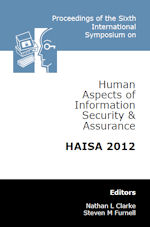In 2014, we launched our open-access repository which offers full text access to conference proceedings from many of our events including the INC and HAISA series. These papers are free to access and distribute (subject to citing the source).
» Openaccess proceedings » 6th International Symposium on Human Aspects of Information Security and Assurance (HAISA 2012)
 | 6th International Symposium on Human Aspects of Information Security and Assurance (HAISA 2012) |
Title: Utilizing Survival Analysis for Modeling Child Hazards of Social Networking
Author(s): Dimitrios Michalopoulos, Ioannis Mavridis
Reference: pp195-204
Keywords: Social networks, grooming, sexual exploitation, survival analysis
Abstract: Social networks induce several hazards to children, which are correlated with the amount of time that children are exposed to those networks. To this end, this work investigates the relation of the aforementioned hazards with the exposure time. To address this issue, we adopt techniques used in survival analysis. These techniques involve the estimation of certain functions which reflect the relation of a disastrous event with time. In particular, we derive the distribution of the rate at which suspicious activities towards children occur in social networks. This is accomplished through experiments on data sets extracted from Facebook. The results show that the incoming hazards for minor female profiles follow the Logistic distribution, while the corresponding hazards for minor male profiles follow the Normal distribution. This knowledge is then utilized for developing an effective system for automated grooming recognition, by optimizing the detection threshold as a function of time. Thus, the threshold sensitivity can be appropriately adjusted such that lower frequencies of occurrence lead to lower threshold sensitivities, and higher frequencies of occurrence lead to higher threshold sensitivities.
Download count: 1823
How to get this paper:


PDF copy of this paper is free to download. You may distribute this copy providing you cite this page as the source.
